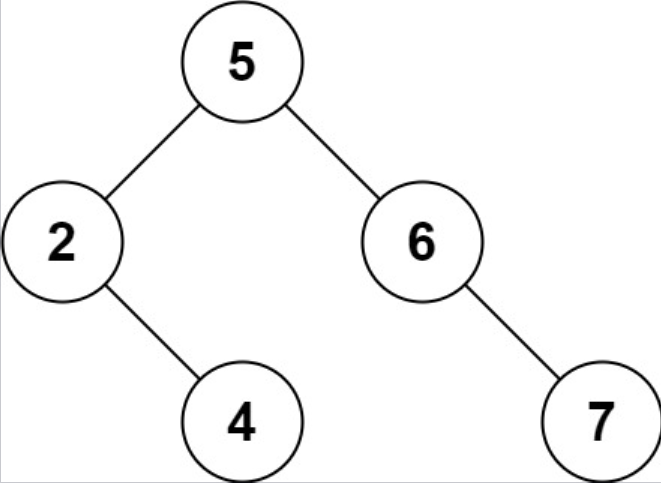2024/1/17大约 3 分钟
一、题目描述
给定一个二叉搜索树的根节点root和一个值key,删除二叉搜索树中的key对应的节点,并保证二叉搜索树的性质不变。返回二叉搜索树(有可能被更新)的根节点的引用。
一般来说,删除节点可分为两个步骤:
- 首先找到需要删除的节点;
- 如果找到了,删除它。
示例 1
输入: root = [5, 3, 6, 2, 4, null, 7], key = 3
输出: [5, 4, 6, 2, null, null, 7]
解释: 给定需要删除的节点值是3,所以我们首先找到3这个节点,然后删除它。
一个正确的答案是 [5, 4, 6, 2, null, null, 7], 如上图所示。
另一个正确答案是 [5, 2, 6, null, 4, null, 7]。
示例 2
输入: root = [5, 3, 6, 2, 4, null, 7], key = 0
输出: [5, 3, 6, 2, 4, null, 7]
解释: 二叉树不包含值为0的节点
示例 3
输入: root = [], key = 0
输出: []
提示
- 节点数的范围
[0, 10⁴]. -10⁵ <= Node.val <= 10⁵- 节点值唯一
root是合法的二叉搜索树-10⁵ <= key <= 10⁵
进阶
要求算法时间复杂度为O(h),h为树的高度。
相关主题
- 树
- 二叉搜索树
- 二叉树
二、题解
Rust节点定义
#[derive(Debug, PartialEq, Eq)]
pub struct TreeNode {
pub val: i32,
pub left: Option<Rc<RefCell<TreeNode>>>,
pub right: Option<Rc<RefCell<TreeNode>>>,
}
impl TreeNode {
#[inline]
pub fn new(val: i32) -> Self {
TreeNode {
val,
left: None,
right: None,
}
}
}Java节点定义
public class TreeNode {
int val;
TreeNode left;
TreeNode right;
TreeNode() {}
TreeNode(int val) { this.val = val; }
TreeNode(int val, TreeNode left, TreeNode right) {
this.val = val;
this.left = left;
this.right = right;
}
}方法 1: 递归
Rust
pub fn delete_node(mut root: Option<Rc<RefCell<TreeNode>>>, key: i32) -> Option<Rc<RefCell<TreeNode>>> {
const DELETE: fn(&mut Option<Rc<RefCell<TreeNode>>>, i32, Option<Rc<RefCell<TreeNode>>>, bool) =
|root, key, mut parent, is_left| {
if let Some(curr) = root {
let curr_val = curr.borrow().val;
if curr_val == key {
let right = curr.borrow_mut().right.take();
let left = curr.borrow_mut().left.take();
let child = if right.is_some() {
let mut leftmost = right.clone();
while let Some(ref curr) = leftmost {
let left = curr.borrow().left.clone();
if left.is_none() {
break;
} else {
leftmost = left;
}
}
if let Some(curr) = leftmost {
curr.borrow_mut().left = left;
}
right
} else {
left
};
if let Some(p) = parent {
if is_left {
p.borrow_mut().left = child;
} else {
p.borrow_mut().right = child;
}
} else {
*root = child;
}
} else {
parent = Some(curr.clone());
if key < curr_val {
let mut left = curr.borrow().left.clone();
DELETE(&mut left, key, parent, true)
} else {
let mut right = curr.borrow().right.clone();
DELETE(&mut right, key, parent, false)
}
}
}
};
DELETE(&mut root, key, None, false);
root
}Java
@FunctionalInterface
interface QuadrConsumer<A, B, C, D> {
void accept(A a, B b, C c, D d);
}
QuadrConsumer<TreeNode[], Integer, TreeNode, Boolean> delete = (roots, key, parent, isLeft) -> {
TreeNode root = roots[0];
if (root == null) {
return;
}
if (root.val == key) {
TreeNode child;
if (root.right != null) {
child = root.right;
TreeNode leftmost = root.right;
while (leftmost.left != null) {
leftmost = leftmost.left;
}
leftmost.left = root.left;
} else {
child = root.left;
}
if (parent == null) {
roots[0] = child;
} else {
if (isLeft) {
parent.left = child;
} else {
parent.right = child;
}
}
} else {
if (key < root.val) {
this.delete.accept(new TreeNode[]{root.left}, key, root, true);
} else {
this.delete.accept(new TreeNode[]{root.right}, key, root, false);
}
}
};
public TreeNode deleteNode(TreeNode _root, int key) {
TreeNode[] root = {_root};
this.delete.accept(root, key, null, false);
return root[0];
}方法 2: 迭代
Rust
pub fn delete_node(mut root: Option<Rc<RefCell<TreeNode>>>, key: i32) -> Option<Rc<RefCell<TreeNode>>> {
let mut parent: Option<Rc<RefCell<TreeNode>>> = None;
let mut is_left = false;
let mut curr_node = root.clone();
while let Some(curr) = curr_node {
let curr_val = curr.borrow().val;
if curr_val == key {
let left = curr.borrow_mut().left.take();
let right = curr.borrow_mut().right.take();
let child = if right.is_some() {
let mut leftmost = right.clone();
while let Some(ref curr) = leftmost {
let left = curr.borrow().left.clone();
if left.is_none() {
break;
}
leftmost = left;
}
if let Some(curr) = leftmost {
curr.borrow_mut().left = left;
}
right
} else {
left
};
if let Some(p) = parent {
if is_left {
p.borrow_mut().left = child;
} else {
p.borrow_mut().right = child;
}
} else {
root = child;
}
break;
} else {
parent = Some(curr.clone());
if key < curr_val {
is_left = true;
curr_node = curr.borrow().left.clone();
} else {
is_left = false;
curr_node = curr.borrow().right.clone();
}
}
}
root
}Java
public TreeNode deleteNode(TreeNode root, int key) {
TreeNode parent = null;
boolean isLeft = false;
TreeNode curr = root;
while (curr != null) {
if (curr.val == key) {
TreeNode child;
if (curr.right != null) {
child = curr.right;
TreeNode leftmost = curr.right;
while (leftmost.left != null) {
leftmost = leftmost.left;
}
leftmost.left = curr.left;
} else {
child = curr.left;
}
if (parent == null) {
root = child;
} else {
if (isLeft) {
parent.left = child;
} else {
parent.right = child;
}
}
break;
} else {
parent = curr;
if (key < curr.val) {
isLeft = true;
curr = curr.left;
} else {
isLeft = false;
curr = curr.right;
}
}
}
return root;
}